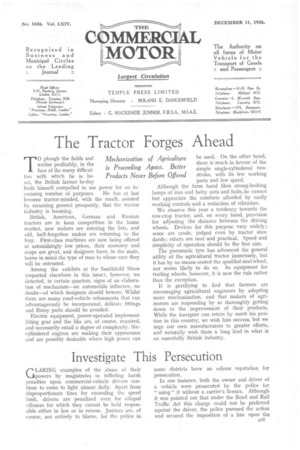The Tractor Forges Ahead
Page 35

If you've noticed an error in this article please click here to report it so we can fix it.
Mechanization of Agriculture is Proceeding Apace. Better Products Never Before Offered
T0 plough the fields and scatter profitably, in the face of the many difficulties with which lie is beset, the British farmer to-day finds himself compelled to use power for an in creasing number of purposes. He has at last become tractor-minded, with the result, assisted by returning general prosperity, that the tractor industry is booming.
British, American, 'German and Russian tractors are in keen competition in the home market, new makers are entering the lists, and old, half-forgotten makes are returning to the fray. First-class machines are now being offered at astonishingly low prices, their economy and scope are great, and designers have, in the main, borne in mind the type of man to whose care they will be entrusted.
Among the exhibits at the Smithfield Show (reported elsewhere in this issue), however, we detected, in certain quarters, signs of an elaboration of mechanism—an automobile influence, no doubt—of which designers should beware. Whilst there are many road-vehicle refinements that can advantageously be incorporated, delicate fittings and flimsy parts should be avoided.
Electric equipment, power-operated implementlifting gear and the like are, of course, required, and necessarily entail a degree of complexity. Sixcylindered engines are making their appearance and are possibly desirable where high power can be used. On the other hand, there is much in favour of the simple single-cylindered twostroke, with its few working parts and low speed.
Although the farm hand likes strong-looking lumps of iron and hefty nuts and bolts, he cannot but appreciate the comforts afforded by easily working controls and a reduction of vibration.
We observe this year a tendency towards the row-crop tractor, and, on every hand, provision for adjusting the distance between the driving wheels. Devices for this purpose vary widely ; some are crude, judged even by tractor standards; others are neat and practical. Speed and simplicity of operation should be the first aim.
The pneumatic tyre has advanced the general utility of the agricultural tractor immensely, but it has by no means ousted the spudded steel wheel, nor seems likely to do so. As equipment for trailing wheels, however, it is now the rule rather than the exception.
It is gratifying to find that farmers are encouraging agricultural engineers by adopting more mechanization, and that makers of agrimotors are responding by so thoroughly getting down to the improvement of their products. While the foreigner can retain by merit his position in this country, we wish him success, but we urge our own manufacturers to greater efforts_ and naturally wish them a long lead in what is an essentially British industry.




































































































